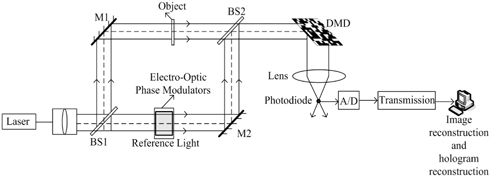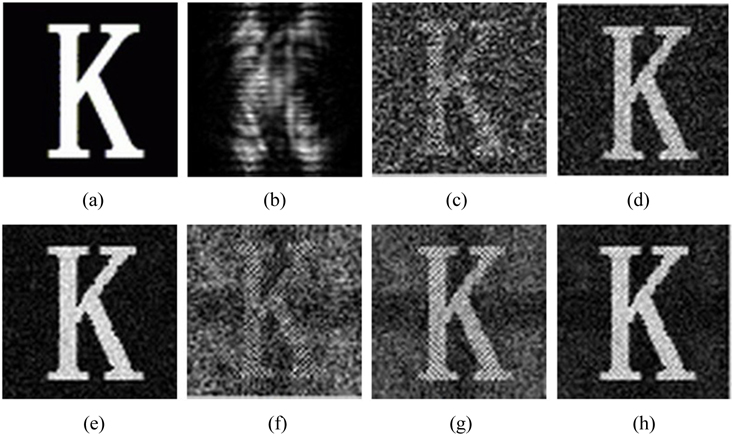



Over the past several years, the huge storage and bandwidth requirements for storing or transmitting holographic data has been a main limiting factor for application of digital hologram technology [1-4]. Fortunately, the newly developed theory known as compressive sensing (CS) [5-7] provides a new direction for imaging system designs. One of the most influential hardware realizations of imaging systems is the CS-based single-pixel camera [8, 9]. Based on compressive sensing, many new applications have already sprung up in the realm of holography. The group of The Duke Imaging and Spectroscopy Program (DISP) first formulated hologram data compression as a compressive sensing problem [10]. Then we may mention on-line compressive holography [11-13], off-axis compressive Fresnel holography [14], compressive incoherent holography [15-16], compressive single exposure on line holography [17]. In the optical domain, few applications of this singlepixel imaging setup in digital holography extending to the coherent regime have been reported although many successful applications of compressive sensing for holography have been demonstrated [11-17].
To fully exploit the advantages of CS theory and holography, we develop a new holographic imaging scheme combining the CS-based single-pixel-camera with holography in the optical domain. Here, we use phase-shifting holography to generate holograms of an object, and then address the acquisition step by measuring the inner products between the hologram and the pseudo-random binary patterns generated by a digital micro-mirror device (DMD). With this method, we can directly acquire the compressed hologram using a photodiode, and never need the CMOS or CCD to record the hologram during the acquisition step. Then the acquired data is processed to produce a reconstruction of the object using reconstruction algorithms of CS. Our team has demonstrated the feasibility of the optical image recovery of four-step phase-shifting holography based on compressive sensing [18-19]. A proof-of-concept experiment evaluating the phase distribution of an ophthalmic lens with three step compressive phase-shifting holography is provided [20]. But it is necessary to record a lot of data with imaging architecture and spend a lot of time conducting an experiment. To overcome this drawback, on the basis of the method of four-step phase shifting holography based on a CS, we propose the establishment of two-step phase shifting holography based on CS, in which half of the data is recorded to reconstruct the original object, speed of the reconstruction time is faster than the four step method. Moreover, when making use of our imaging system to simulate digital holographic imaging, we get holograms generated by the phase-shift digital hologram principle, in this process we use Fresnel to get similar holograms. In the process of recording data of holograms, we can directly acquire the compressed hologram using a photodiode. However, we reconstruct the original object using the compressed hologram rather than directly using holograms generated by the phase-shift digital hologram principle. The data need experience a lossy compression process. Because half of data is reduced in two-step phase shifting holographic method compared with four-step phase shifting holographic method, in two-step phase shifting holographic method error caused by a lossy compression process will be less, real-time performance is also better than four-step phase shifting holographic method. We reconstruct the original object using corresponding hologram algorithm instead of four-step phase shifting algorithm, simulation results demonstate that reconstruction quality of image is better than four-step phase shifting holographic method.
Compressive sensing combines sampling and compression into a single non-adaptive linear measurement process. It is mainly made up of three sections: sparse representation, random projection and reconstruction. This subsection presents a very brief CS overview necessary for the following sections.
Suppose that a basis matrix
A with length N can be well approximated using only
X is the input object, Y with size
III. COMPRESSIVE HOLOGRAPHIC IMAGING SYSTEM BASED ON COMPRESSIVE SENSING
Our holographic imaging setup based on CS theory is shown in Fig. 1. Where a linearly polarized laser beam is expanded, collimated, and then divided into an object beam and a reference beam. The phase of the reference wave is controlled by an electro-optic phase modulator. Then the two waves overlap to form interferograms. A traditional hologram generating device is different in that a single-pixel camera based on CS theory is used to collect signal and compress data in our system. We adopt a Digital Micro-mirror Device(DMD) for producing the measurement matrix Φ and computing random linear measurements of the interferograms
In the case of the two-step algorithm [23] based on the traditional two-step quadrature phase-shifting holography [21-22], when we set the phases of the reference wave in the first and second exposure to 0 and respectively by regulating the electro-optic phase modulator, then two quadrature-phase holograms
The DMD consists of many micro-mirrors, each mirror corresponds to a particular pixel in X and
To compute CS randomized measurements
Y is the measurement data,
Since the hologram is piecewise constant with large gradient at the edge, we adopt a Total Variation(TV) algorithm to measure the
Here we adopt the
In Eq. (11), abs (.) denotes the amplitude of (.);
Transposing and rearranging Eq. (4) and Eq. (5), we can write
The quantity, F(
we can calculate the complex amplitude from Eq. (12)
Putting the optimal value , calculated from the above with CS theory into Eq. (16)
Finally we can get the original object image by the inverse Fresnel transformation.
In the following, we made a series of computer simulations to verify the effectiveness of our method. The object we used was grayscale image “K” as shown in Fig. 2(a) with 64× 64 pixels (hence, N=4096). The measurement matrix Φ generated by the DMD is random sequences of 0/1. The hologram
Fig. 2. The simulation results using our architecture. (a) Original image of letter K. (b) Digital hologram of letter K. (c) Reconstruction from 2048 (50%) measurements using the method of four-step phase shifting holography based on compressive sensing (CS). (d) Reconstruction from 3276 (80%)) measurements using the method of four-step phase shifting holography based on CS. (e) Reconstruction from 3686 (90%) measurements using the method of four-step phase shifting holography based on CS. (f) Reconstruction from 2457 (60%) measurements using current method of two-step phase shifting holography based on CS. (g) Reconstruction from 3276 (80%) measurements using current method of two-step phase shifting holography based on CS. (h) Reconstruction from 3686 (90%) measurements using current method of two-step phase shifting holography based on CS.
In this paper, we reconstruct an original image by recording two holograms in the optical domain using certain signal recovery algorithms of CS theory and hologram reconstruction techniques, which greatly enhances the hologram photography and recovery efficiency. First, we can directly acquire the compressed hologram using a photodiode and never need the CMOS or CCD to record the hologram during the acquisition step, which reduces the complexity and size of holographic imaging devices. In addition, speed of the reconstruction time is faster than the four step method. Real-time performance in two-step phase shifting is also better than that in four-step phase shifting. It will make coherent dynamic imaging possible. Our method is useful for substantially reducing the bandwidth or storage requirements of detector pixels and the scanning effort in the acquisition step. The most significant advantage about the holographic imaging system design is the enhancement of detector efficiency, because only significant components in the images’ transformed space, which are important for people’s visual perception, are collected. Our current work involves improving the quality of the image reconstruction according to the feature of hologram and CS theory, in the meantime, we are building an experimental platform for verification.

